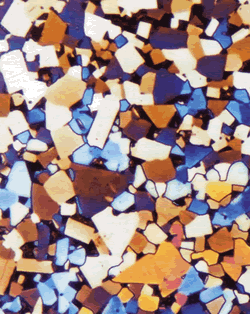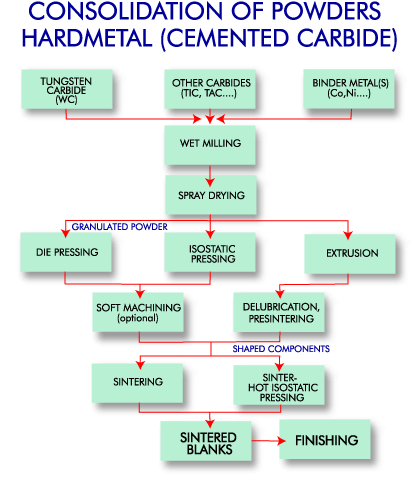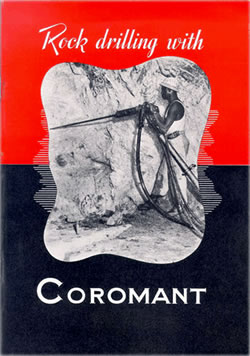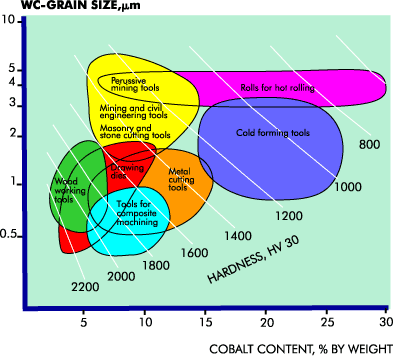Cemented Carbides
The main use of tungsten (in the form of tungsten carbide) is in the manufacture of cemented carbides. After Scheele’s discovery of "Tungsten" in 1781, it took an additional 150 years before his successors’ efforts led to the application of tungsten carbide in the industry.
Cemented carbides, or hard metals as they are often called, are materials made by "cementing" very hard tungsten monocarbide (WC) grains in a binder matrix of tough cobalt metal by liquid phase sintering.

The combination of WC and metallic cobalt as a binder is a well-adjusted system not only with regard to its properties, but also to its sintering behaviour.
The high solubility of WC in cobalt at high temperatures and a very good wetting of WC by the liquid cobalt binder result in an excellent densification during liquid phase sintering and in a pore-free structure. As a result of this, a material is obtained which combines high strength, toughness and high hardness.
The beginning of tungsten carbide production may be traced to the early 1920’s, when the German electrical bulb company, Osram, looked for alternatives to the expensive diamond drawing dies used in the production of tungsten wire.
These attempts led to the invention of cemented carbide, which was soon produced and marketed by several companies for various applications where its high wear resistance was particularly important. The first tungsten carbide-cobalt grades were soon successfully applied in the turning and milling of cast iron and, in the early 1930’s, the pioneering cemented carbide companies launched the first steel-milling grades which, in addition to tungsten carbide and cobalt, also contained carbides of titanium and tantalum.
By the addition of titanium carbide and tantalum carbide, the high temperature wear resistance, the hot hardness and the oxidation stability of hardmetals have been considerably improved, and the WC-TiC-(Ta,Nb)C-Co hardmetals are excellent cutting tools for the machining of steel. Compared to high speed steel, the cutting speed increased from 25 to 50 m/min to 250 m/min for turning and milling of steel, which revolutionized productivity in many industries.

Shortly afterwards, the revolution in mining tools began. The first mining tools with cemented carbide tips increased the lifetime of rock drills by a factor of at least ten compared to a steel-based drilling tool.
In all these applications, there has been a continuous expansion in the consumption of cemented carbide from an annual world total of 10 tons in 1930; to 100 tons around 1935; 1,000 tons in the early 1940’s; through 10,000 tons in the early 1960’s and up to nearly 30,000 tons at present.
 The development of metal cutting tools has been very rapid over the last four decades, having been greatly stimulated by much improved design and manufacturing techniques, e.g. the introduction of indexable inserts in the 1950’s and the invention of coated grades around 1970.
The development of metal cutting tools has been very rapid over the last four decades, having been greatly stimulated by much improved design and manufacturing techniques, e.g. the introduction of indexable inserts in the 1950’s and the invention of coated grades around 1970.
The first coating was with a thin layer (~5 μm thick) of titanium carbide made by a Chemical Vapour Deposition (CVD) process. It improved the lifetime of tools by a factor of 2 to 5.
This technique has since been improved by multilayer coatings, where layers of alumina, titanium nitride, titanium aluminium nitride and other materials have been added which have further improved the lifetimes by 5 to 10 times.
However, coating and improved design are only one side of the coin. Continuous improvement of intermediates and manufacturing techniques led to improved performance of hardmetals and opened new areas of applications. The introduction of solvent extraction in tungsten chemistry, new techniques in hydrogen reduction and carburization improved the purity and uniformity of tungsten and tungsten carbide powder.
In parallel, new powder milling, spray drying and sintering techniques resulted in improved hardmetal properties and performance. Notably, the continuous improvement of vacuum sintering technology and, starting from the late 1980’s, hot isostatic pressure sintering (SinterHIP) led to new standards in hardmetal quality.
The history of tungsten powder metallurgy, and especially that of the hardmetal industry, is characterized by a steadily widening range of available grain sizes for processing in the industry; while, at the same time, the grain size distribution for each grade of WC powder became narrower and narrower.
The most important reason for this widening of the spectrum of available WC grades is that, besides those variations achieved by cobalt contents and some carbide additives, the properties of WC-Co hardmetals such as hardness, toughness, strength, modulus of elasticity, abrasion resistance and thermal conductivity can be widely varied by means of the WC grain size. While the spectrum of available WC grain sizes ranged from 2.0 to 5.0 μm in the early days of the hardmetal industry in the mid 1920’s, the grain sizes of WC powders now used in hardmetals range from 0.15 μm to 50 μm, or even 150 μm for some very special applications.
Based on the wide range of grain sizes now available, not only very hard and abrasion resistant, but also very tough, hardmetals can be produced for widespread applications in high tech tools, wear parts and mining tools as well as for many sectors of the engineering industry.
There has been a rapid development in mining and stone cutting tools, with improved performance which has led to the increasing substitution of steel tools by cemented carbide tools, in particular in the oil industry. Notably, the use of very coarse grained hardmetals is growing in this application area.
A large portion of the tungsten volume in cemented carbide is today used in wear part applications, where there is a wide range of products from the very small (such as balls for ball-point pens) to large and heavy products, such as punches, dies or hot rolls for rolling mills in the steel industry.
Most of these wear parts and the mining tools are made of straight WC-Co hardmetals without any addition of other carbides.
Fine and ultrafine grained WC hardmetals have become more and more important today in the field of wear parts, tools for chipless forming and cutting tools for cast iron, non ferrous alloys and wood.

Application range of straight grade cemented carbides
The first submicron hardmetals were launched on the market in the late 1970s and, since this time, the microstructures of such hardmetals have become finer and finer. The main interest in hardmetals with such finer grain sizes derives from the understanding that hardness and wear resistance increase with decreasing WC grain size.
A special application for these fine or ultrafine WC hardmetals, involving large quantities of cemented carbide, is in drills for the drilling of the very fine holes in printed circuit boards for the computer and electronic industries. For this purpose, new cemented carbide compositions, based on extremely fine-grained carbide, have been introduced.
| Basic data for different WC-Co and WC-(W,Ti,Ta,Nb)C-Co hardmetal grades |
||||||
| Grade (wt%) |
Hardness HV30 |
Compressive strength (N × mm -2) |
Transverse rupture strength (N × mm -2) |
Young’s modulus (kN × mm -2) |
Fracture toughness (MPa × m -1/2) |
Mean thermal expansion coefficient (10 -6 × K -1) |
| WC-4Co | 2000 | 7100 | 2000 | 665 | 8.5 | 5.0 |
| WC-6Co/S* | 1800 | 6000 | 3000 | 630 | 10.8 | 6.2 |
| WC-6Co/M** | 1580 | 5400 | 2000 | 630 | 9.6 | 5.5 |
| WC-6Co/C*** | 1400 | 5000 | 2500 | 620 | 12.8 | 5.5 |
| WC-25Co/M | 780 | 3100 | 2900 | 470 | 14.5 | 7.5 |
| WC-6Co-9.5 (Ti,Ta,Nb)C |
1700 | 5950 | 1750 | 580 | 9.0 | 6.0 |
| WC-9Co-31 (Ti,Ta,Nb)C |
1560 | 4500 | 1700 | 520 | 8.1 | 7.2 |
S* = submicron; M** = fine/medium; C*** = coarse






 sales@chinatungsten.com
sales@chinatungsten.com